Eliminating Measles: Factors That Contribute to Re-Establishing Transmission
Abstract
1. Introduction
2. Materials and Methods
2.1. Data Sources
2.2. Study Design
2.3. Model Inputs
3. Results
3.1. Socioeconomic Status
3.2. Bordering a Measles Endemic Country
3.3. Population Density
3.4. The Role of Tourism
3.5. Vaccination Timing and Coverage
3.6. Campaigns
3.7. Generalized Linear Models
4. Discussion
5. Conclusions
Supplementary Materials
Author Contributions
Funding
Data Availability Statement
Acknowledgments
Conflicts of Interest
Appendix A
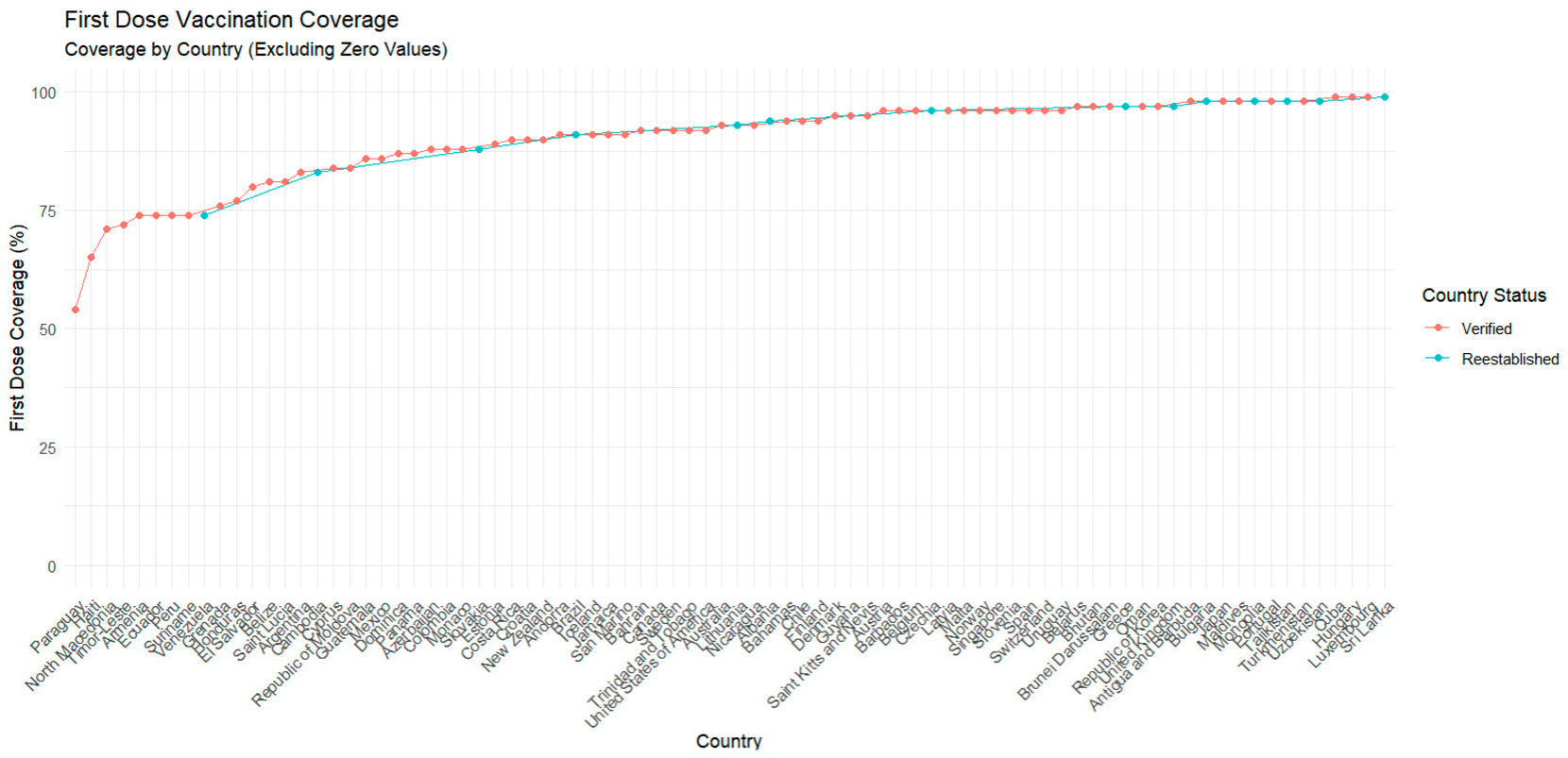
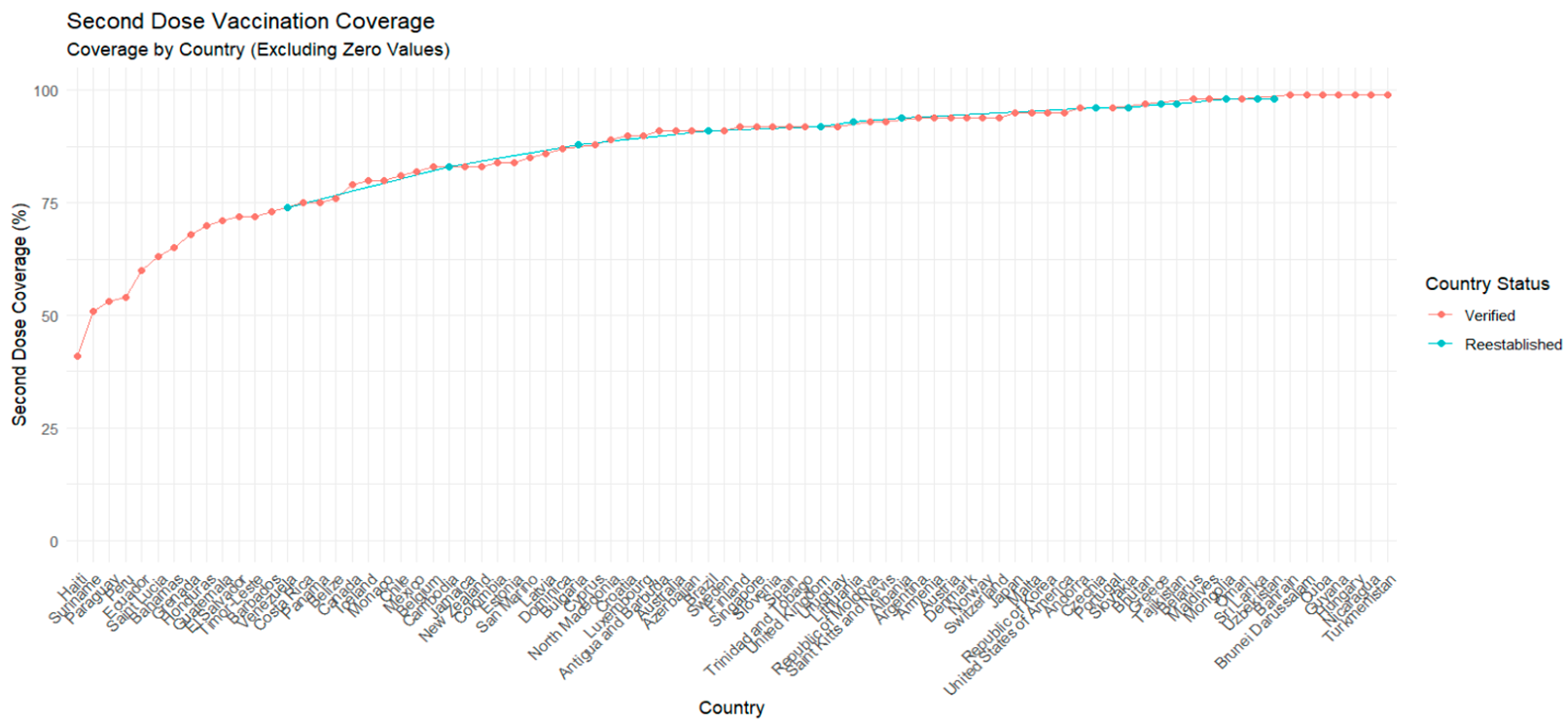
References
- Durrheim, D.N.; Crowcroft, N.S.; Strebel, P.M. Measles—The epidemiology of elimination. Vaccine 2014, 32, 6880–6883. [Google Scholar] [CrossRef] [PubMed]
- Dowdle, W.R. The principles of disease elimination and eradication. Bull. World Health Organ. 1998, 76, S22–S25. [Google Scholar]
- World Health Organization. Weekly epidemiological record. Wkly. Epidemiol. Rec. 2017, 92, 205–228. [Google Scholar]
- World Health Organization. Framework for verifying elimination of measles and rubella. Wkly. Epidemiol. Rec. 2013, 88, 89–99. [Google Scholar]
- European Centre for Disease Prevention and Control. Measles Annual Epidemiological Report for 2018; ECDC: Stockholm, Sweden, 2018. [Google Scholar]
- Anderson, R.M.; May, R.M. Directly transmitted infections diseases: Control by vaccination. Science 1982, 215, 1053–1060. [Google Scholar] [CrossRef]
- De Serres, G.; Gay, N.J.; Farrington, C.P. Epidemiology of transmissible diseases after elimination. Am. J. Epidemiol. 2000, 151, 1039–1048. [Google Scholar] [CrossRef]
- Gay, N.J. The theory of measles elimination: Implications for the design of elimination strategies. J. Infect. Dis. 2004, 189, S27–S35. [Google Scholar] [CrossRef]
- Winter, A.K.; Lambert, B.; Klein, D.; Klepac, P.; Papadopoulos, T.; Truelove, S.; Burgess, C.; Santos, H.; Knapp, J.K.; Reef, S.E.; et al. Feasibility of measles and rubella vaccination programmes for disease elimination: A modelling study. Lancet Glob. Health 2022, 10, e1412–e1422. [Google Scholar] [CrossRef] [PubMed]
- Chan, J.C.H.; Rosa Duque, J.S.; Durrheim, D.N.; Tsang, T.; Lau, Y.L. Achieving and sustaining measles elimination in Hong Kong, from 1967 to 2024: Lessons to be learnt. BMJ Glob. Health 2025, 10, e018973. [Google Scholar] [CrossRef] [PubMed]
- Huits, R.; Buonfrate, D.; O’Laughlin, K.; Hamer, D.H.; Libman, M. Measles importations by international travelers, GeoSentinel 2019–2025. Travel Med. Infect. Dis. 2025, 67, 102885. [Google Scholar] [CrossRef]
- Yamakawa, M.; Tokinobu, A.; Tanaka, Y.; Matsushita, N.; Hashizume, M. Missed opportunities for measles vaccination among departing travelers from Japan to India. J. Travel Med. 2020, 27, taz086. [Google Scholar] [CrossRef] [PubMed]
- Hagan, J.; Dashpagma, O.; Vichit, O.; Chham, S.; Demberelsuren, S.; Grabovac, V.; Hossain, S.; Iijima, M.; Lee, C.W.; Purevdagva, A.; et al. Challenges for sustaining measles elimination: Post-verification large-scale import-related measles outbreaks in Mongolia and Cambodia, resulting in the loss of measles elimination status. Vaccines 2024, 12, 821. [Google Scholar] [CrossRef] [PubMed]
- Muscat, M.; Ben Mamou, M.; Reynen-de Kat, C.; Jankovic, D.; Hagan, J.; Singh, S.; Datta, S.S. Progress and challenges in measles and rubella elimination in the WHO European Region. Vaccines 2024, 12, 696. [Google Scholar] [CrossRef] [PubMed]
- Rodríguez-Morales, A.J.; Suárez, J.A.; Risquez, A.; Cimerman, S.; Valero-Cedeño, N.; Cabrera, M.; Grobusch, M.P.; Paniz-Mondolfi, A. In the eye of the storm: Infectious disease challenges for border countries receiving Venezuelan migrants. Travel Med. Infect. Dis. 2019, 30, 4–6. [Google Scholar] [CrossRef]
- Takashima, Y.; Aslam, S.K.; Evans, R.; Mariano, K.M.; Lee, C.W.; Wang, X.; Grabovac, V.; Durrheim, D.N. Measles and rubella elimination in the Western Pacific Region in 2013-2022: Lessons learned from progress and achievements made during regional and global measles resurgences. Vaccines 2024, 12, 817. [Google Scholar] [CrossRef]
- Bartlett, M.S. Measles periodicity and community size. J. R. Stat. Soc. 1957, 120, 48–70. [Google Scholar] [CrossRef]
- Black, F.L. Measles endemicity in insular populations: Critical community size and its evolutionary implications. J. Theor. Biol. 1966, 11, 207–211. [Google Scholar] [CrossRef]
- Durrheim, D.N.; Tuibeqa, I.V.; Aho, G.S.; Grangeon, J.P.; Ogaoga, D.; Wattiaux, A.; Mariano, K.M.; Evans, R.; Hossain, S.; Aslam, S.K. Pacific Island Countries demonstrate the sustained success of a coordinated measles mass vaccination campaign. Lancet Reg. Health West. Pac. 2024, 42, 100998. [Google Scholar] [CrossRef]
- Evans-Gilbert, T.; Broome, K.; Irons, B.; Lewis-Bell, K.N.; Ferdinand, E.; Figueroa, J.P. Lessons for sustaining the elimination of measles, rubella, and congenital rubella syndrome in the Caribbean. Rev. Panam. Salud Publica 2024, 48, e60. [Google Scholar] [CrossRef]
- World Health Organization. WHO/UNICEF Estimation of National Immunization Coverage; WHO/UNICEF Estimates: Geneva, Switzerland, 2024. [Google Scholar]
- Danovaro-Holliday, M.C.; Gacic-Dobo, M.; Diallo, M.S.; Murphy, P.; Brown, D.W. Compliance of WHO and UNICEF estimates of national immunization coverage (WUENIC) with Guidelines for Accurate and Transparent Health Estimates Reporting (GATHER) criteria. Gates Open Res. 2021, 5, 77. [Google Scholar] [CrossRef]
- Clark, A.; Sanderson, C. Timing of children’s vaccinations in 45 low-income and middle-income countries: An analysis of survey data. Lancet 2009, 373, 1543–1549. [Google Scholar] [CrossRef] [PubMed]
- World Health Organization Regional Office for Europe. Report of the 6th Meeting of the European Technical Advisory Group of Experts (ETAGE); WHO Regional Office for Europe: Copenhagen, Denmark, 2006; Available online: https://iris.who.int/bitstream/handle/10665/369481/WHO-EURO-2006-7692-47459-69763-eng.pdf (accessed on 29 October 2025).
- World Health Organization Regional Office for Europe. Sixty Years of WHO in Europe; WHO Regional Office for Europe: Copenhagen, Denmark, 2011; Available online: https://iris.who.int/bitstream/handle/10665/107273/E93312.pdf (accessed on 29 October 2025).
- Hagan, J.E.; Crooke, S.N.; Gunregjav, N.; Sowers, S.B.; Mercader, S.; Hickman, C.J.; Mulders, M.N.; Pastore, R.; Takashima, Y.; Durrheim, D.N.; et al. Breakthrough Measles among Vaccinated Adults Born during the Post-Soviet Transition Period in Mongolia. Vaccines 2024, 12, 695. [Google Scholar] [CrossRef]
- World Health Organization Regional Office for South-East Asia. Midterm Review of the “Strategic Plan for Measles Elimination and Rubella and Congenital Rubella Syndrome Control in the South-East Asia Region: 2014–2020”; WHO Regional Office for South-East Asia: New Delhi, India, 2018; Available online: https://iris.who.int/handle/10665/279993 (accessed on 30 October 2025).
- Rota, P.A.; Evans, R.; Ben Mamou, M.C.; Rey-Benito, G.; Sangal, L.; Dosseh, A.; Ghoniem, A.; Byabamazima, C.R.; Demanou, M.; Anderson, R.; et al. The Global Measles and Rubella Laboratory Network supports high-quality surveillance. Vaccines 2024, 12, 946. [Google Scholar] [CrossRef] [PubMed]
- Branswell, S. Philanthropies Rush to Save Measles Surveillance Network Pushed to Brink of Collapse by Trump Administration; STAT: Boston, MA, USA, 2025. [Google Scholar]
- Kaufman, J.; Rak, A.; Vasiliadis, S.; Brar, N.; Atif, E.; White, J.; Danchin, M.; Durrheim, D.N. The Case for Assessing the Drivers of Measles Vaccine Uptake. Vaccines 2024, 12, 692. [Google Scholar] [CrossRef] [PubMed]

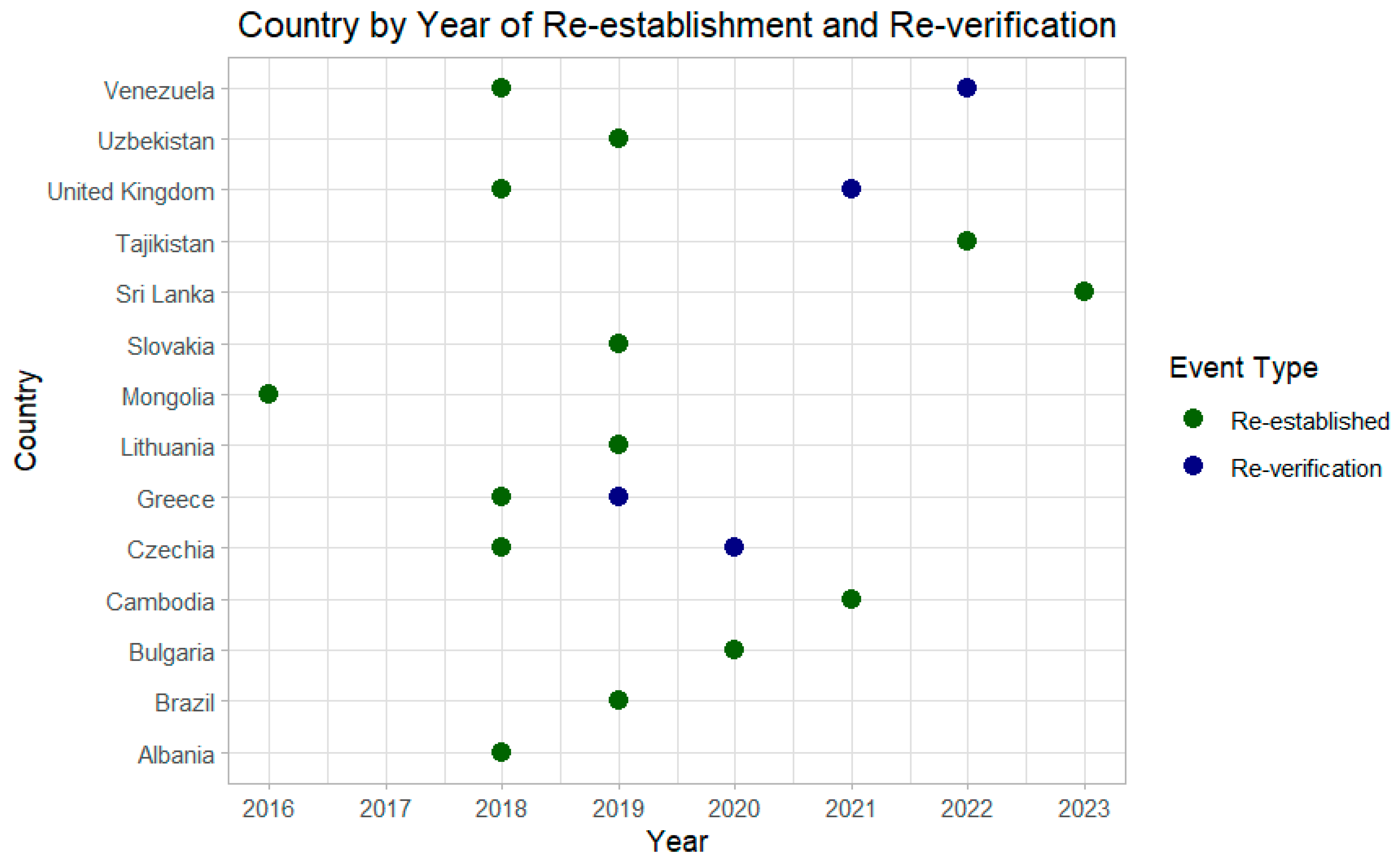

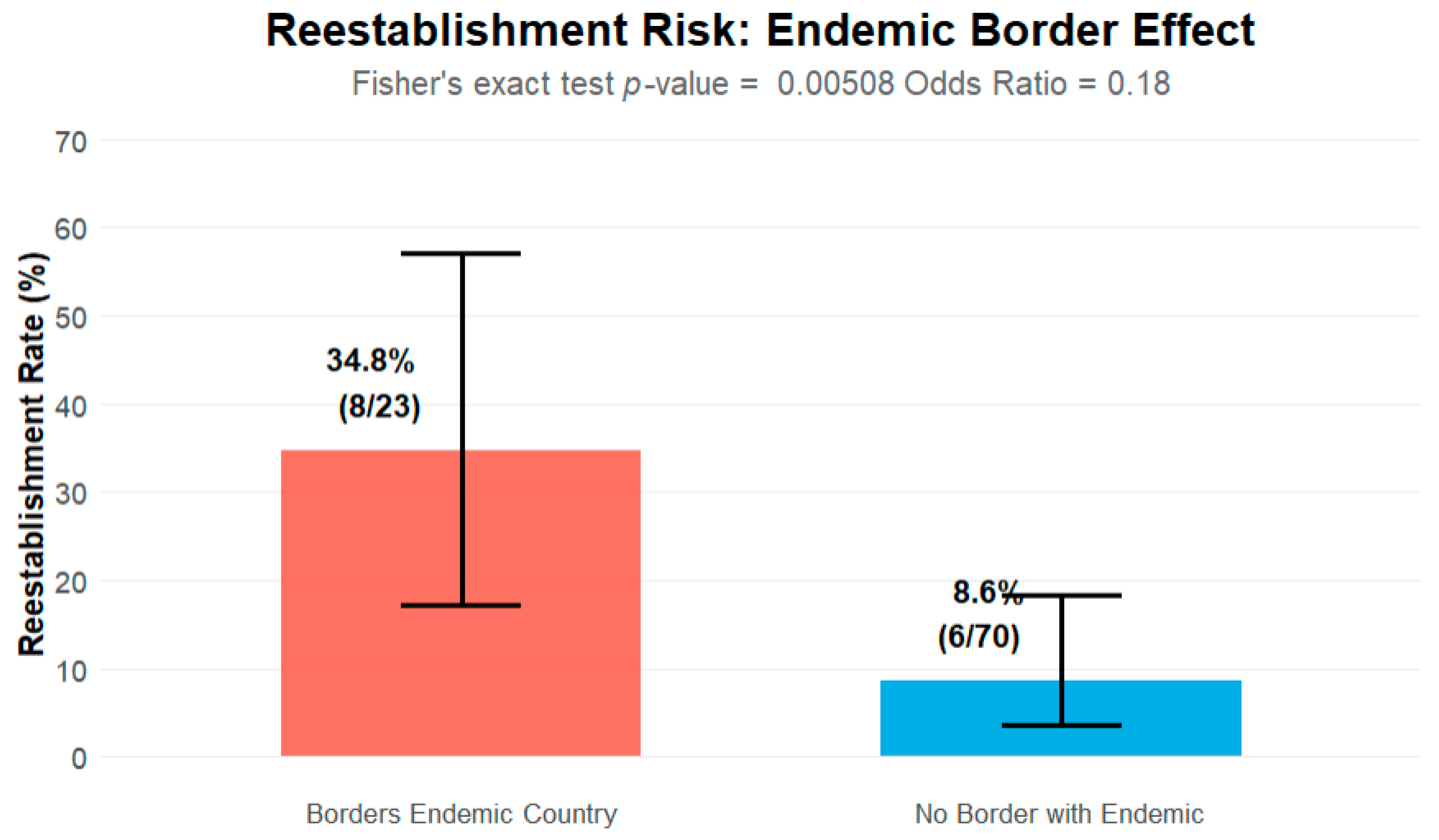
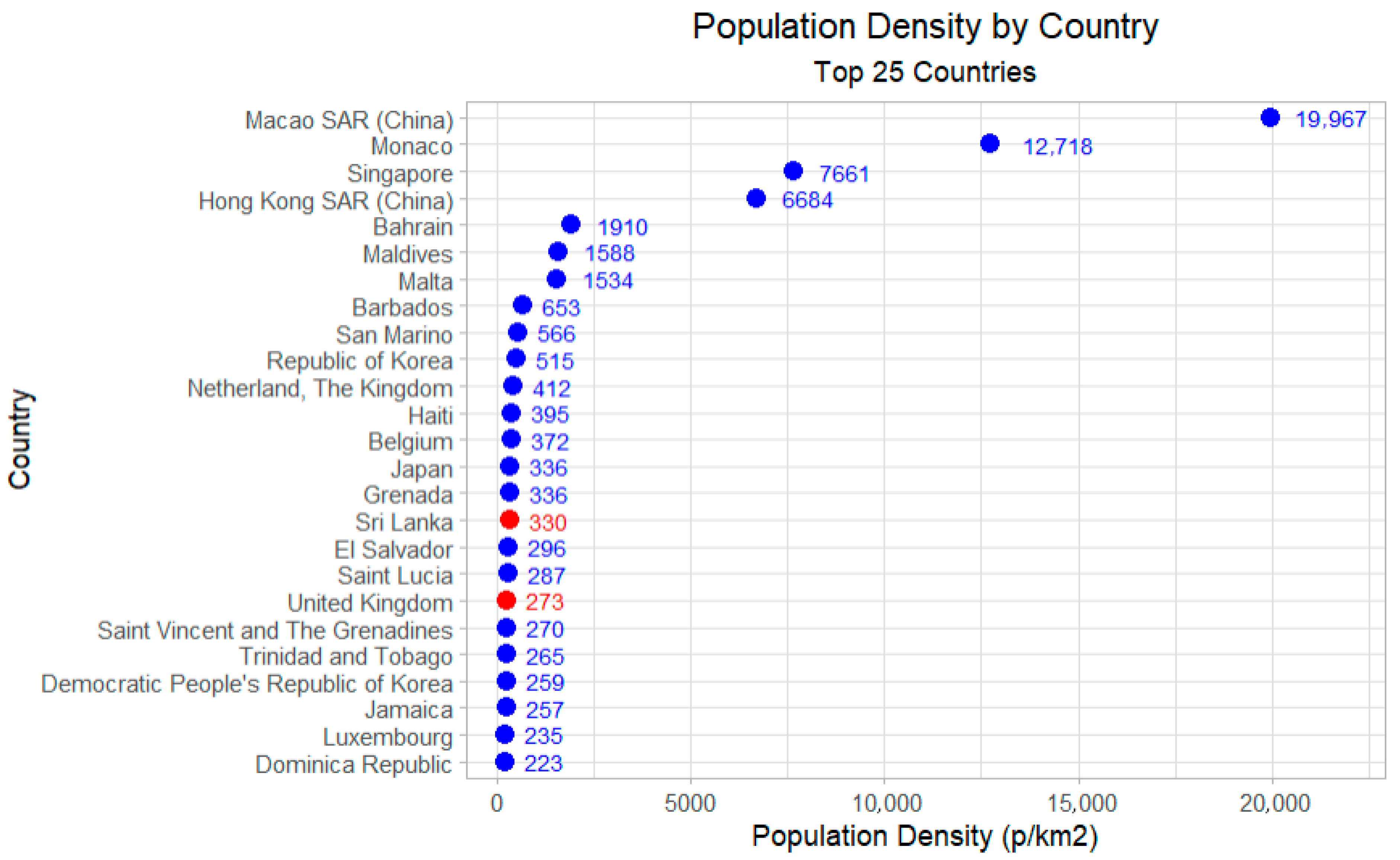



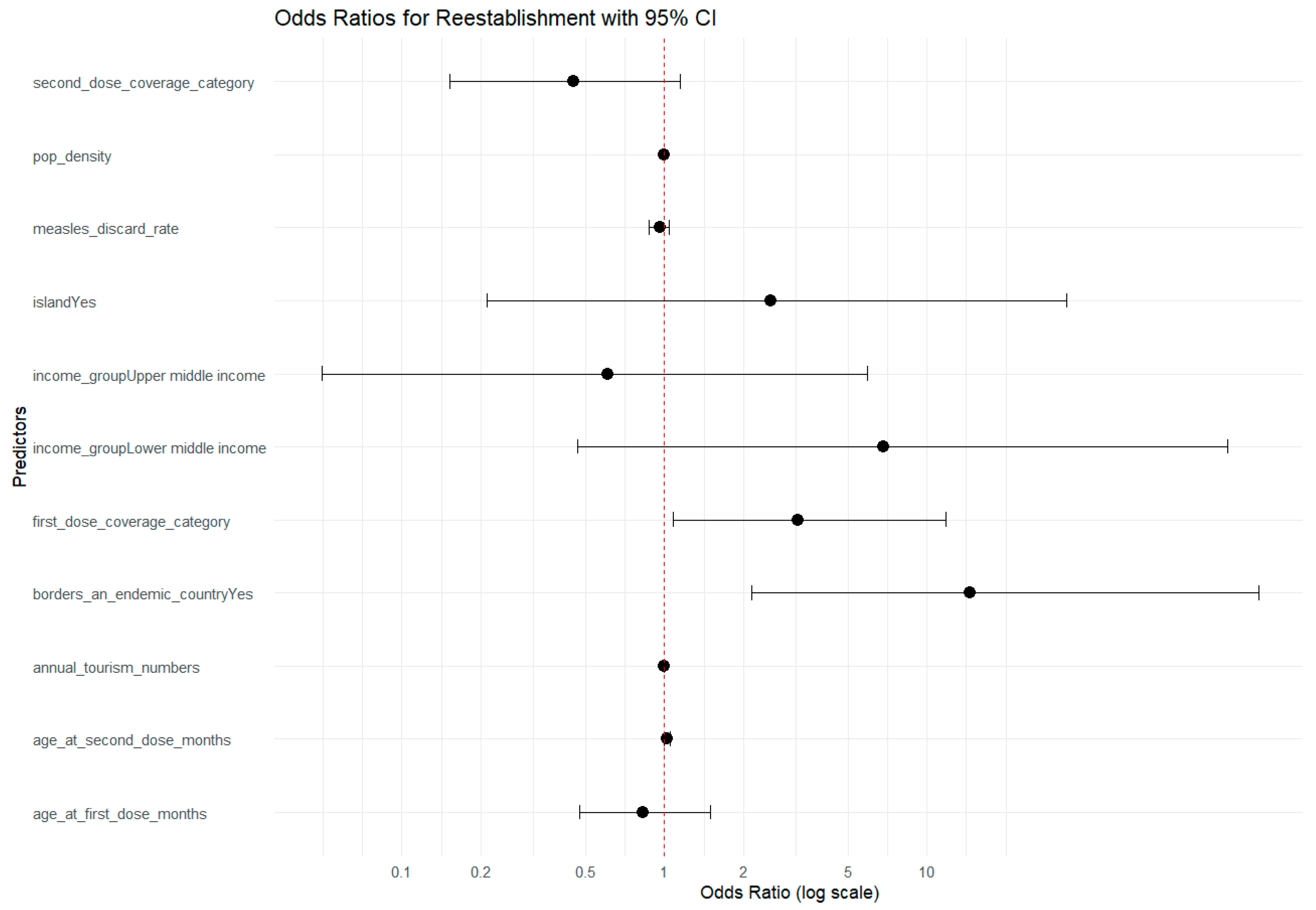
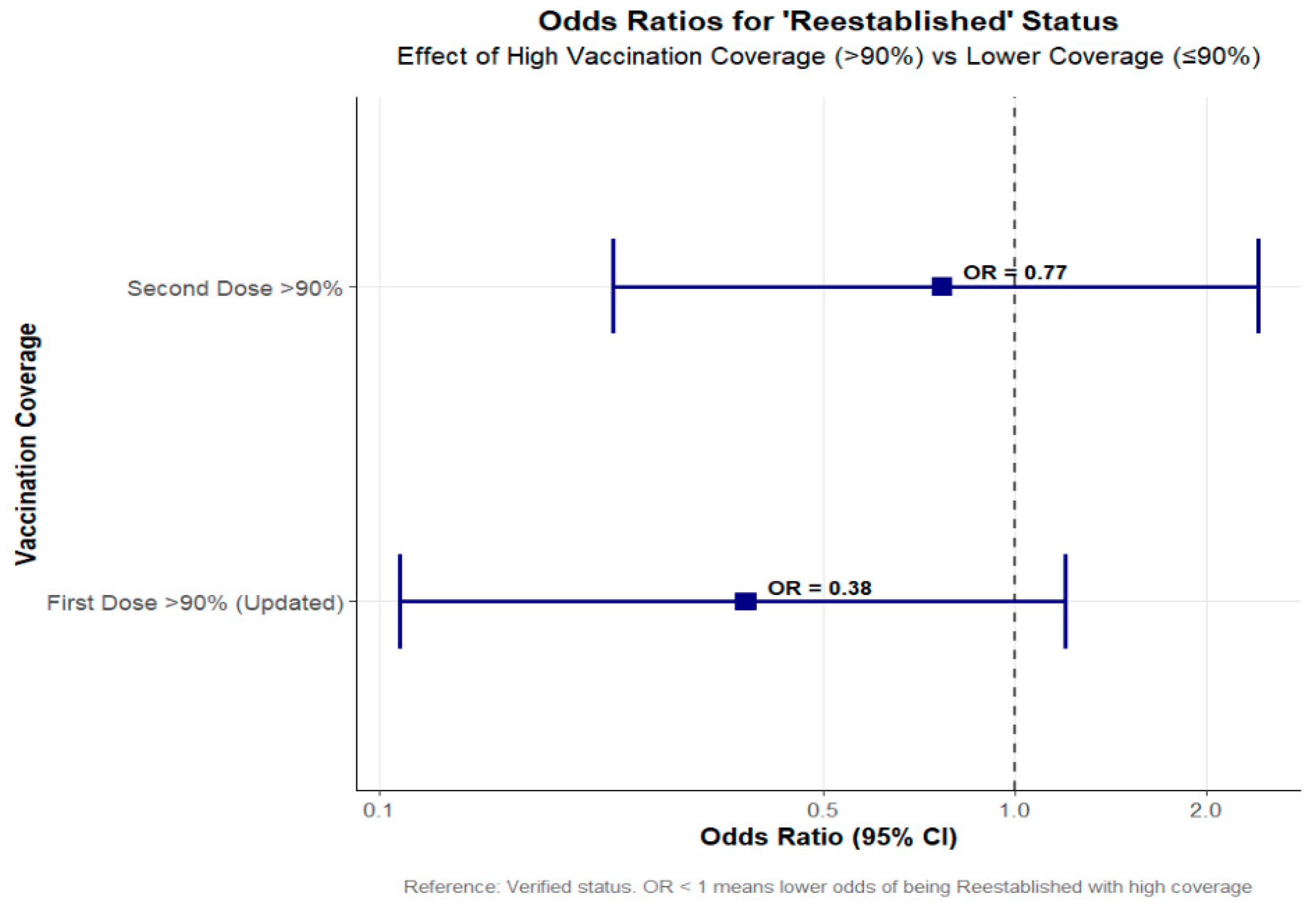
| Dataset | Source | Timepoint | URL (Where Applicable) |
|---|---|---|---|
| Global Measles Elimination Status | WHO | 2011–2023 | |
| MCV Campaign Data | WHO | 2000–2025 | |
| Measles Reported Cases and Incidence Rates | WHO | 2011–2023 | |
| Measles Vaccination Coverage Dose One | WHO | 2011–2022 | |
| Measles Vaccination Coverage Dose Two | WHO | 2011–2022 | |
| Vaccination Schedule for Measles | WHO | Current Data | Vaccination schedule for measles (https://immunizationdata.who.int/global/wiise-detail-page/vaccination-schedule-for-measles?ISO_3_CODE=&TARGETPOP_GENERAL= (accessed on 29 October 2025)) |
| Tourism Numbers | World Bank | Current Data | https://data.worldbank.org/indicator/ST.INT.ARVL (accessed on 29 October 2025) |
| Tourism Data/Tourist Tracker | United Nations | 2018–2023 | https://www.unwto.org/tourism-data/un-tourism-tracker (accessed on 29 October 2025) |
| Factor | Description |
|---|---|
| Dose coverage | Country estimates of first and second MCV dose coverage |
| Population density | The population density value for each country in the dataset |
| Measles discard rate | The number or suspected measles cases tested and discarded as negative (also a proxy for surveillance quality) |
| Socioeconomic status | The socioeconomic status for each country in the dataset, per the World Bank designation |
| Annual tourism numbers | The annual number of tourist visitors to each country, per World Bank data |
| Age at first and second dose | The age (in months) at which each country schedules first and second dose vaccination of children, considered separately |
| Island status | Whether a country is classified as an island |
| Bordering an endemic country | Whether the country bordered at least one country considered endemic for measles |
| Re-Established | Verified | |
|---|---|---|
| Minimum | 2 | 3 |
| 1st quartile | 48 | 28.5 |
| Median | 101 | 777 |
| 3rd quartile | 108.5 | 258 |
| Maximum | 330 | 19,967 |
| First Dose Coverage | Risk Ratio (95% Confidence Interval) |
|---|---|
| <90% coverage | 1.11 (0.95, 1.31) |
| <80% coverage | 1.12 (0.95–1.32) |
| <70% coverage | 1.19 (1.09–1.31) |
| Second Dose Coverage | |
| <90% coverage | 1.00 (0.85, 1.19) |
| <80% coverage | 1.07 (0.91, 1.27) |
| <70% coverage | 0.99 (0.80, 1.23) |
| Country | Verification Year | Intervention Year |
|---|---|---|
| Brazil | 2016 | 2014 |
| Bulgaria | 2012 | 2010 |
| Cambodia | 2015 | 2013 |
| Mongolia | 2014 | 2012 |
| United Kingdom | 2016 | 2013 |
| Venezuela | 2016 | 2013, 2014 |
| Country | First Dose Coverage—Alternate | First Dose Coverage—WUENIC | Data Source | Year |
|---|---|---|---|---|
| Albania | 79 | 95 | DHS | 2017 |
| Brazil | 73 | 91 | PAHO | 2021 |
| Cambodia | 83 | 83 | DHS | 2021 |
| Greece | 89.8 | 97 | Publication (Vaccines) | 2020 |
| Lithuania | 87.2 | 93 | Publication (Medical Sciences) | 2023 |
| Mongolia | 81.9 | 98 | MICS | 2023 |
| Venezuela | 68 | 74 | PAHO | 2021 |
Disclaimer/Publisher’s Note: The statements, opinions and data contained in all publications are solely those of the individual author(s) and contributor(s) and not of MDPI and/or the editor(s). MDPI and/or the editor(s) disclaim responsibility for any injury to people or property resulting from any ideas, methods, instructions or products referred to in the content. |
© 2025 by the authors. Licensee MDPI, Basel, Switzerland. This article is an open access article distributed under the terms and conditions of the Creative Commons Attribution (CC BY) license (https://creativecommons.org/licenses/by/4.0/).
Share and Cite
Gibson, E.; Durrheim, D.N.; O’Connor, P. Eliminating Measles: Factors That Contribute to Re-Establishing Transmission. Vaccines 2025, 13, 1125. https://doi.org/10.3390/vaccines13111125
Gibson E, Durrheim DN, O’Connor P. Eliminating Measles: Factors That Contribute to Re-Establishing Transmission. Vaccines. 2025; 13(11):1125. https://doi.org/10.3390/vaccines13111125
Chicago/Turabian StyleGibson, Emily, David N. Durrheim, and Patrick O’Connor. 2025. "Eliminating Measles: Factors That Contribute to Re-Establishing Transmission" Vaccines 13, no. 11: 1125. https://doi.org/10.3390/vaccines13111125
APA StyleGibson, E., Durrheim, D. N., & O’Connor, P. (2025). Eliminating Measles: Factors That Contribute to Re-Establishing Transmission. Vaccines, 13(11), 1125. https://doi.org/10.3390/vaccines13111125






